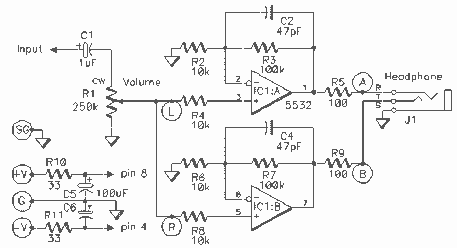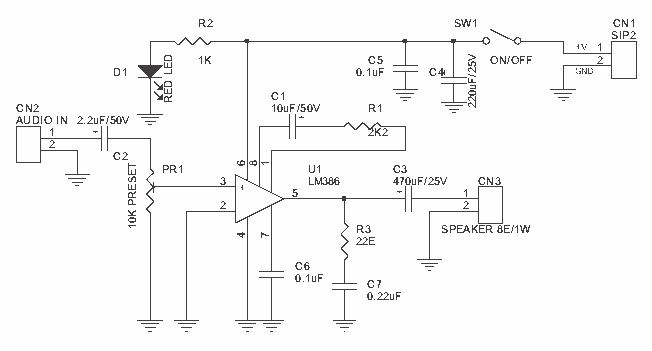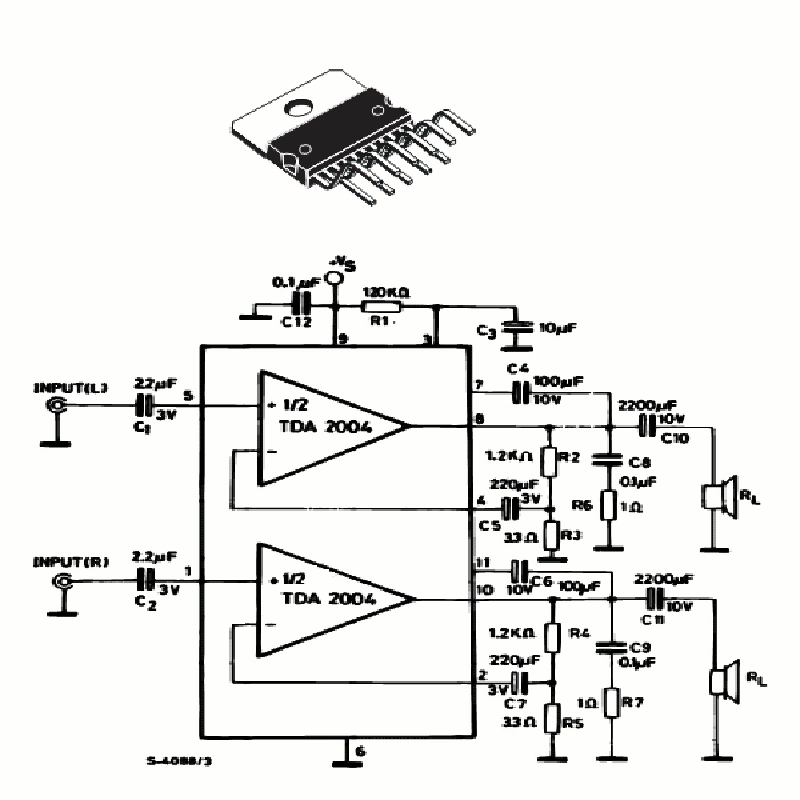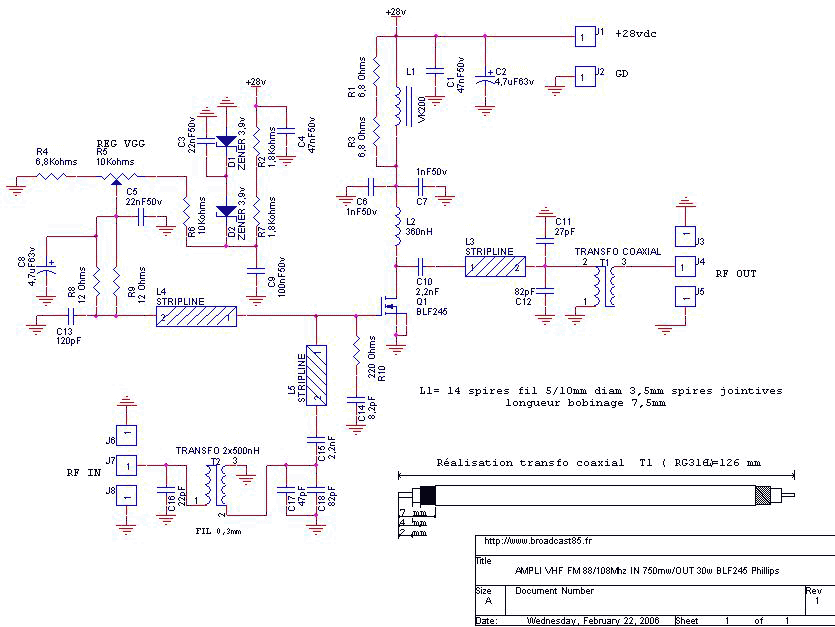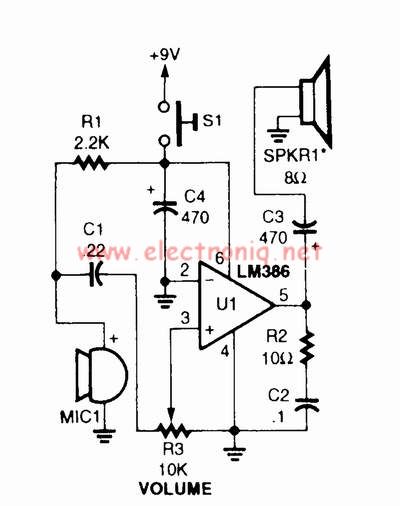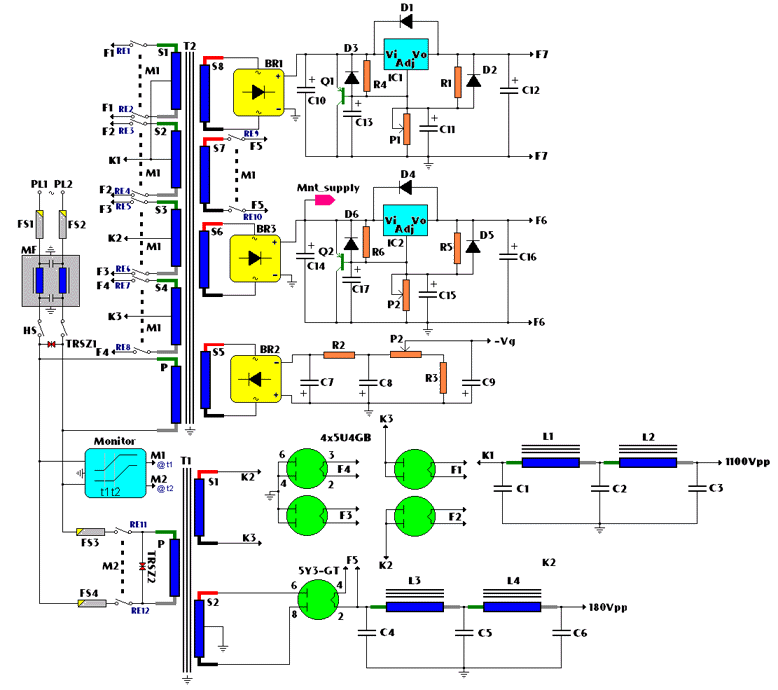
TMB-1 Tri-Mode Buffer Amplifier Box
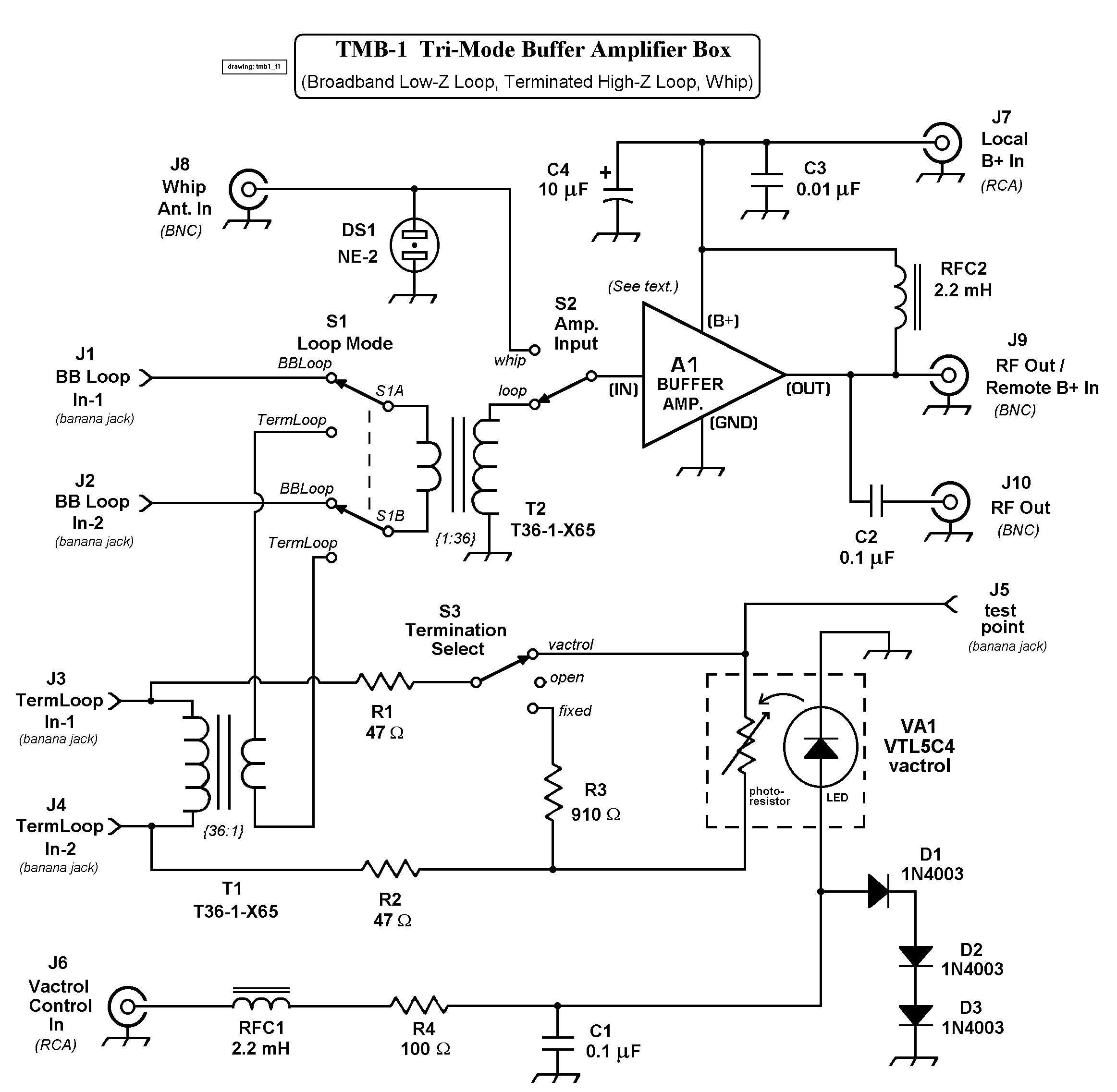
The TMB-1 is an RF amplifier unit and receiving accessory compatible with low-impedance broadband loops, high-impedance terminated loops (such as Pennant, Flag, or Kaz Delta), and whip (telescoping rod) antennas. This design is optimized for operation within the frequency range of 0.5 to 2.0 MHz, suitable for medium wave broadcasts and 160-meter amateur radio use. While sensitivity is slightly diminished in the 150-500 kHz and 2-6 MHz ranges for longwave, tropical band, and 80-meter amateur operation, the unit remains functional. Modifications to the RF transformers would be required to enhance performance in other frequency ranges. The accompanying schematic illustrates the TMB-1 circuit. The buffer amplifier is a generic building-block assembly consisting of an input, output, DC power, and ground. The schematic for this amplifier card follows the main TMB-1 drawing, and a table of suitable integrated circuit buffers is also included. Antenna elements (loop or whip) and the TMB-1 unit are often located away from the receiving position, typically on the roof of a building, atop a mast, or in an open field. Occasionally, multiple antennas are deployed at significant distances (over 30 meters) apart to form a phased array. DC power is transmitted to and RF output is received from connector J9 of the TMB-1 through a 50-ohm coaxial cable. At the receiving position, DC is separated through an inductor, and RF is separated through a capacitor, utilizing a classic bias tee arrangement. This configuration is generally integrated into the phasing unit or preselector ahead of the receiver. Some receivers may include a built-in DC-biased RF port. If the TMB-1 is positioned near the receiving unit, DC power (+12 V to +15 V typically) can be supplied to J7, and DC-blocked RF can be directed to the receiver (or phaser) at J10. Testing of the TMB-1 and several competing antenna amplifier designs was conducted in March 2002 across various locations, including Billerica, MA, East Harwich, MA, and the Rowley, MA salt-marsh DXpedition site. All three types of antennas (broadband loop, terminated loop, whip) were evaluated. A low-impedance broadband loop typically consists of a single turn of wire measuring between 1/40 to 1/10 of the wavelength in total length, equating to 4.17 to 16.67 meters at 1.8 MHz. When formed into a square, each side measures one-quarter of the total length, while in a circular formation, the diameter equals the total length divided by pi (3.1416). Most testing was conducted with a single-turn square loop, measuring 8 meters (26.25 feet) in total wire length, or 2 meters (6.56 feet) per side. With the broadband loop connected at J1 and J2, switch S1 is set to BBLoop, and S2 is set to Loop. The 1:36 step-up transformer (T2) amplifies the input voltage presented to the high-impedance buffer amplifier card input. This card provides unity voltage gain while achieving significant current gain, converting a high-impedance input signal to an output impedance compatible with a 50-ohm coaxial feedline and receiver input. The buffer amplifier features a low noise floor and can manage signals with a peak-to-peak amplitude of up to half the supply voltage, exhibiting low harmonic and intermodulation distortion. With a +12 VDC supply, signals up to 6 Vp-p (2.12 Vrms or +19.5 dBm) can be amplified cleanly with most buffer ICs. If the wire loop presents an input impedance of 50 ohms, the T2 transformer and A1 buffer card combination yields a gain of approximately 17 dB. Recent tests with a Flag antenna, measuring 10.36 meters (34 feet) horizontally and 4.88 meters (16 feet) on the two vertical sides, showed promising results. The lower horizontal section was positioned approximately 2.44 meters (8 feet) above ground during testing in Billerica and East Harwich. Typically, the Flag antenna is fed halfway up one side.
The TMB-1 circuit design incorporates various components that ensure effective amplification and signal processing. The RF transformers are critical in determining the frequency response and overall performance of the amplifier. The buffer amplifier is designed to maintain signal integrity while providing necessary gain, making it suitable for various antenna configurations. The inclusion of a bias tee allows for seamless integration of DC power and RF signals, facilitating flexible deployment of the antenna system. Furthermore, the TMB-1's adaptability to different antenna types enhances its utility in diverse operational scenarios, making it a versatile tool for radio frequency applications. The performance metrics achieved during testing indicate that the TMB-1 can effectively amplify weak signals, making it a valuable asset for amateur radio enthusiasts and professionals alike. The design considerations and testing results underscore the importance of optimizing the amplifier for specific frequency ranges to maximize its effectiveness in various communication environments.The TMB-1 is an RF amplifier unit / receiving accessory that can be used with a low-impedance broadband loop, a high-impedance terminated loop (such as a Pennant, Flag, or Kaz Delta), and whip (telescoping rod) antennas. This particular design is optimized for 0. 5 to 2. 0 MHz operation (medium wave broadcast and 160-m amateur). Sensitivity is sligh tly less, though still usable, in the 150-500 kHz and 2-6 MHz ranges for longwave, tropical band, and 80-m amateur operation. Circuit changes, mostly with regards to the RF transformers, would be necessary for better performance on other frequency ranges.
The accompanying schematic drawing shows the TMB-1 circuit. The buffer amplifier is considered as a generic building-block assembly having an input, an output, DC power, and ground. The schematic of this amplifier card follows the main TMB-1 drawing. A table of suitable integrated circuit buffers is also presented. The antenna element (loop or whip) and TMB-1 box are often situated somewhere other than at the receiving position.
Typical sites include the roof of a building or vehicle, the top of a mast, or out in a field. Sometimes two or more antennas are deployed a considerable distance (over 30 m) apart to form a phased array. DC power is transferred to, and RF output from, connector J9 of the TMB-1 through the 50-ohm coaxial cable.
At the receiving position, DC is split off through an inductor and RF through a capacitor (the classic bias tee arrangement). This would normally be built into the phasing unit or preselector ahead of the receiver. A few receivers may themselves have a built-in DC-biased RF port. If the TMB-1 is used close to the receiving position, you can supply DC power (+12 V to +15 V typically) to J7 and take DC-blocked RF out to the receiver (or phaser) at J10.
In March of 2002, I put the TMB-1 and several other competing antenna amplifier designs through a series of tests at home in Billerica, MA and also at East Harwich, MA (Cape Cod) and out at the Rowley, MA salt-marsh DXpedition site. All three types of antennas (broadband loop, terminated loop, whip) were evaluated. A low-impedance broadband loop , for the purposes of this article, is usually comprised of a single turn of wire between 1/40 to 1/10 wavelength in total length.
This would equate to a total length of 4. 17 to 16. 67 meters at 1. 8 MHz. If this wire is formed into a square, each side will be one quarter the total length. If it is formed into a circle, the diameter will be the total length divided by pi (3. 1416). I have done most of my testing with a single-turn square loop, 8 m (26. 25 ft. ) total wire length or 2 m (6. 56 ft. ) per side. With the broadband loop winding connected at J1 and J2, switch S1 is set to BBLoop and S2 is set to Loop. The 1:36 step-up transformer (T2) multiplies the input voltage to be presented to the high-impedance buffer amplifier card input.
This card performs unity voltage gain but considerable current gain in taking an input signal of a very high impedance down to an output impedance compatible with 50-ohm coaxial feedline and receiver input. The buffer amplifier has a low noise floor and it can handle signals with a peak-to-peak amplitude of as much as half the supply voltage with reasonably low harmonic and intermodulation distortion.
With a +12 VDC supply, signals up to 6 Vp-p (2. 12 Vrms or +19. 5 dBm) can be amplified cleanly with most buffer IC`s. If the wire loop has an input impedance of 50 ohms, the T2 transformer to A1 buffer card combination gives a gain of approximately 17 dB. I have had very good luck recently with a Flag antenna. The antenna is rectangular and measures 10. 36 m (34 ft. ) horizontally and 4. 88 m (16 ft. ) on the two vertical sides. The distance of the lower horizontal section above the ground was approximately 2. 44 m (8 ft. ) in the Billerica and East Harwich tests. Normally the Flag antenna is fed halfway up one 🔗 External reference
The TMB-1 circuit design incorporates various components that ensure effective amplification and signal processing. The RF transformers are critical in determining the frequency response and overall performance of the amplifier. The buffer amplifier is designed to maintain signal integrity while providing necessary gain, making it suitable for various antenna configurations. The inclusion of a bias tee allows for seamless integration of DC power and RF signals, facilitating flexible deployment of the antenna system. Furthermore, the TMB-1's adaptability to different antenna types enhances its utility in diverse operational scenarios, making it a versatile tool for radio frequency applications. The performance metrics achieved during testing indicate that the TMB-1 can effectively amplify weak signals, making it a valuable asset for amateur radio enthusiasts and professionals alike. The design considerations and testing results underscore the importance of optimizing the amplifier for specific frequency ranges to maximize its effectiveness in various communication environments.The TMB-1 is an RF amplifier unit / receiving accessory that can be used with a low-impedance broadband loop, a high-impedance terminated loop (such as a Pennant, Flag, or Kaz Delta), and whip (telescoping rod) antennas. This particular design is optimized for 0. 5 to 2. 0 MHz operation (medium wave broadcast and 160-m amateur). Sensitivity is sligh tly less, though still usable, in the 150-500 kHz and 2-6 MHz ranges for longwave, tropical band, and 80-m amateur operation. Circuit changes, mostly with regards to the RF transformers, would be necessary for better performance on other frequency ranges.
The accompanying schematic drawing shows the TMB-1 circuit. The buffer amplifier is considered as a generic building-block assembly having an input, an output, DC power, and ground. The schematic of this amplifier card follows the main TMB-1 drawing. A table of suitable integrated circuit buffers is also presented. The antenna element (loop or whip) and TMB-1 box are often situated somewhere other than at the receiving position.
Typical sites include the roof of a building or vehicle, the top of a mast, or out in a field. Sometimes two or more antennas are deployed a considerable distance (over 30 m) apart to form a phased array. DC power is transferred to, and RF output from, connector J9 of the TMB-1 through the 50-ohm coaxial cable.
At the receiving position, DC is split off through an inductor and RF through a capacitor (the classic bias tee arrangement). This would normally be built into the phasing unit or preselector ahead of the receiver. A few receivers may themselves have a built-in DC-biased RF port. If the TMB-1 is used close to the receiving position, you can supply DC power (+12 V to +15 V typically) to J7 and take DC-blocked RF out to the receiver (or phaser) at J10.
In March of 2002, I put the TMB-1 and several other competing antenna amplifier designs through a series of tests at home in Billerica, MA and also at East Harwich, MA (Cape Cod) and out at the Rowley, MA salt-marsh DXpedition site. All three types of antennas (broadband loop, terminated loop, whip) were evaluated. A low-impedance broadband loop , for the purposes of this article, is usually comprised of a single turn of wire between 1/40 to 1/10 wavelength in total length.
This would equate to a total length of 4. 17 to 16. 67 meters at 1. 8 MHz. If this wire is formed into a square, each side will be one quarter the total length. If it is formed into a circle, the diameter will be the total length divided by pi (3. 1416). I have done most of my testing with a single-turn square loop, 8 m (26. 25 ft. ) total wire length or 2 m (6. 56 ft. ) per side. With the broadband loop winding connected at J1 and J2, switch S1 is set to BBLoop and S2 is set to Loop. The 1:36 step-up transformer (T2) multiplies the input voltage to be presented to the high-impedance buffer amplifier card input.
This card performs unity voltage gain but considerable current gain in taking an input signal of a very high impedance down to an output impedance compatible with 50-ohm coaxial feedline and receiver input. The buffer amplifier has a low noise floor and it can handle signals with a peak-to-peak amplitude of as much as half the supply voltage with reasonably low harmonic and intermodulation distortion.
With a +12 VDC supply, signals up to 6 Vp-p (2. 12 Vrms or +19. 5 dBm) can be amplified cleanly with most buffer IC`s. If the wire loop has an input impedance of 50 ohms, the T2 transformer to A1 buffer card combination gives a gain of approximately 17 dB. I have had very good luck recently with a Flag antenna. The antenna is rectangular and measures 10. 36 m (34 ft. ) horizontally and 4. 88 m (16 ft. ) on the two vertical sides. The distance of the lower horizontal section above the ground was approximately 2. 44 m (8 ft. ) in the Billerica and East Harwich tests. Normally the Flag antenna is fed halfway up one 🔗 External reference
